Search Result
Results for "
relapsed
" in MedChemExpress (MCE) Product Catalog:
4
Isotope-Labeled Compounds
| Cat. No. |
Product Name |
Target |
Research Areas |
Chemical Structure |
-
- HY-12651A
-
|
|
Parasite
|
Infection
Cancer
|
|
Primaquine is a potent antimalaria agent and a potent gametocytocide in falciparum malaria. Primaquine prevents relapse in vivax and ovale malaria .
|
-

-
- HY-125399
-
|
HBED-CC-PSMA
|
PSMA
|
Cancer
|
|
PSMA-11 is a positron emission tomography (PET) tracer. PSMA-11 detects prostate cancer relapses and metastases by binding to the extracellular domain of prostate-specific membrane antigen (PSMA) .
|
-

-
- HY-109068
-
|
INCB050465; IBI-376
|
PI3K
|
Cancer
|
|
Parsaclisib (INCB050465) is a potent, selective and orally active inhibitor of PI3Kδ, with an IC50 of 1 nM at 1 mM ATP. Parsaclisib shows approximately 20000-fold selectivity over other PI3K class I isoforms. Parsaclisib can be used for the research of relapsed or refractory B-cell malignancies .
|
-
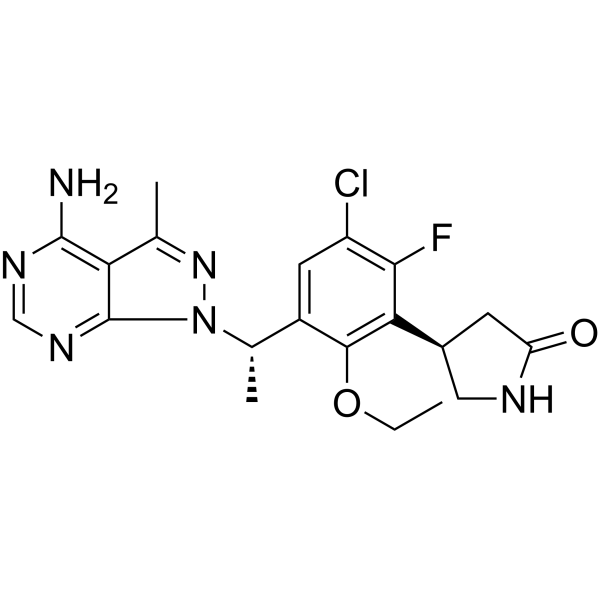
-
- HY-109068A
-
|
INCB050465 hydrochloride; IBI-376 hydrochloride
|
PI3K
|
Cancer
|
|
Parsaclisib hydrochloride (INCB050465 hydrochloride) is a potent, selective and orally active inhibitor of PI3Kδ, with an IC50 of 1 nM at 1 mM ATP. Parsaclisib hydrochloride shows approximately 20000-fold selectivity over other PI3K class I isoforms. Parsaclisib hydrochloride can be used for the research of relapsed or refractory B-cell malignancies .
|
-
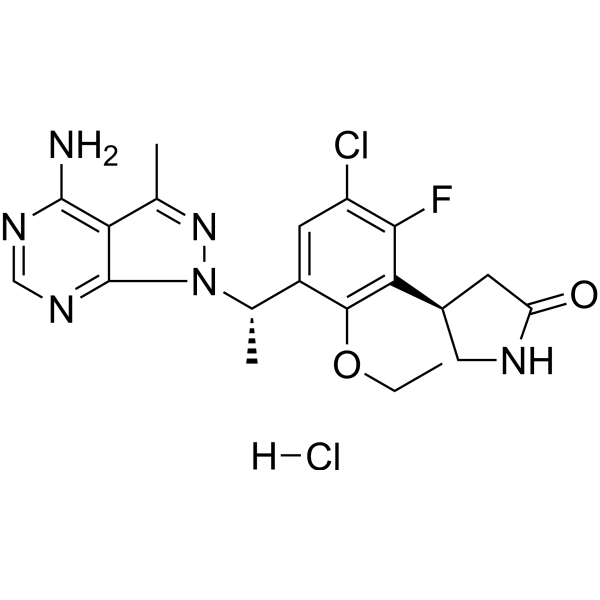
-
- HY-108831A
-
|
|
Integrin
|
Inflammation/Immunology
|
|
Natalizumab (Solution) is a recombinant, humanized IgG4 monoclonal antibody, binds to α4β1-integrin and blocks its interaction with vascular cell adhesion molecule-1 (VCAM-1). Natalizumab can be used for the treatment of relapsing remitting multiple sclerosis and Crohn's disease. Natalizumab is also the first targeted therapy which blocks an essential mechanism for lymphocyte entry to the CNS and thus prevents acute demyelinating relapses .
|
-

-
- HY-144858
-
EZM0414
3 Publications Verification
|
Histone Methyltransferase
|
Cancer
|
|
EZM0414 is a potent, selective, orally bioavailable inhibitor of SETD2 (IC50=18 nM in SETD2 biochemical assay; IC50=34 nM in cellular assay). EZM0414 can be used for the research of relapsed or refractory multiple myeloma and diffuse large B-cell lymphoma .
|
-

-
- HY-13010
-
|
ABR-215062
|
NF-κB
Apoptosis
|
Inflammation/Immunology
|
|
Laquinimod (ABR-215062), an orally available carboxamide derivative, is a potent immunomodulator which prevents neurodegeneration and inflammation in the central nervous system. Laquinimod reduces astrocytic NF-κB activation to protect from Cuprizone-induced demyelination. Laquinimod has the potential for relapsing remitting (RR) and chronic progressive (CP) forms of multiple sclerosis (MS; RRMS or CPMS) as well as neurodegenerative diseases research .
|
-
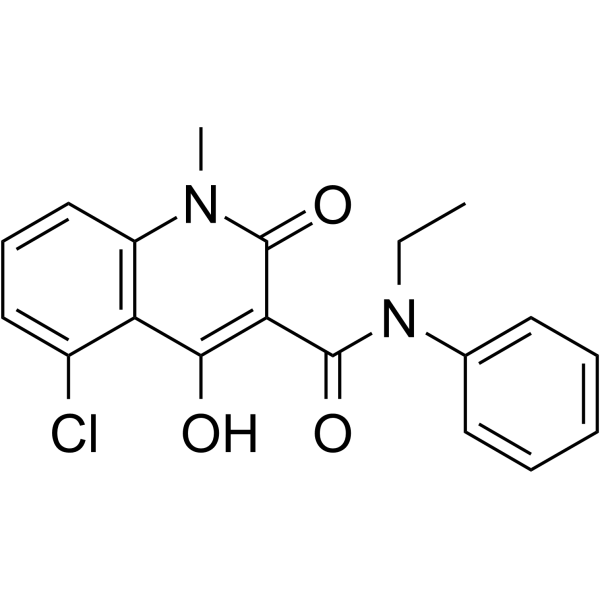
-
- HY-W062904
-
|
ABR-215062 sodium
|
NF-κB
Apoptosis
|
Neurological Disease
Inflammation/Immunology
|
|
Laquinimod (ABR-215062) sodium, an orally available carboxamide derivative, is a potent immunomodulator which prevents neurodegeneration and inflammation in the central nervous system. Laquinimod sodium reduces astrocytic NF-κB activation to protect from Cuprizone-induced demyelination. Laquinimod sodium has the potential for relapsing remitting (RR) and chronic progressive (CP) forms of multiple sclerosis (MS; RRMS or CPMS) as well as neurodegenerative diseases research .
|
-
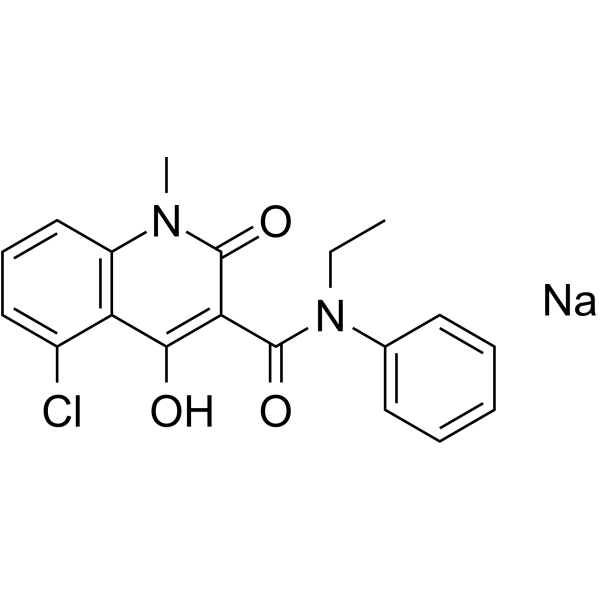
-
- HY-P99033
-
|
BTCT-4465A
|
CD20
CD3
|
Inflammation/Immunology
Cancer
|
|
Mosunetuzumab (BTCT-4465A) is a full-length, fully humanized immunoglobulin G1 (IgG1) T-cell-dependent bispecific (TDB) antibody targeting CD20 (B cells) and CD3 (T cells). Mosunetuzumab redirects T cells to engage and eliminate malignant B cells and can be used for the research of relapsed or refractory (R/R) B-cell non-Hodgkin lymphomas (B-NHLs) .
|
-

-
- HY-13010R
-
|
|
NF-κB
Apoptosis
|
Inflammation/Immunology
|
|
Laquinimod (Standard) is the analytical standard of Laquinimod. This product is intended for research and analytical applications. Laquinimod (ABR-215062), an orally available carboxamide derivative, is a potent immunomodulator which prevents neurodegeneration and inflammation in the central nervous system. Laquinimod reduces astrocytic NF-κB activation to protect from Cuprizone-induced demyelination. Laquinimod has the potential for relapsing remitting (RR) and chronic progressive (CP) forms of multiple sclerosis (MS; RRMS or CPMS) as well as neurodegenerative diseases research .
|
-

-
- HY-14572
-
|
SN 27858
|
DNA Alkylator/Crosslinker
Drug Metabolite
|
Cancer
|
|
PR-104A (SN 27858) is the alcohol metabolite of phosphate proagent PR-104. PR-104A is a hypoxia-selective DNA cross-linking agent/DNA-damaging agent and cytotoxin. Antitumor Activity . PR-104A is metabolized under hypoxia by the 1-electron NADPH:cytochrome P450 oxidoreductase. PR-104A can be used for the research of relapsed/refractory T-lineage acute lymphoblastic leukemia (T-ALL) .
|
-
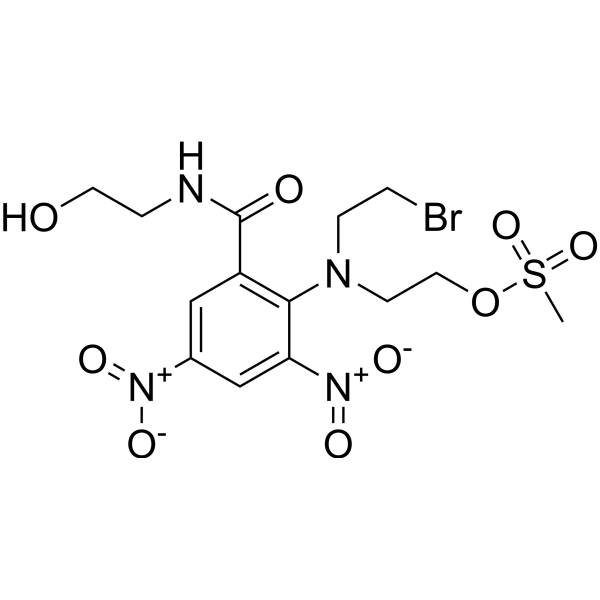
-
- HY-13052
-
-
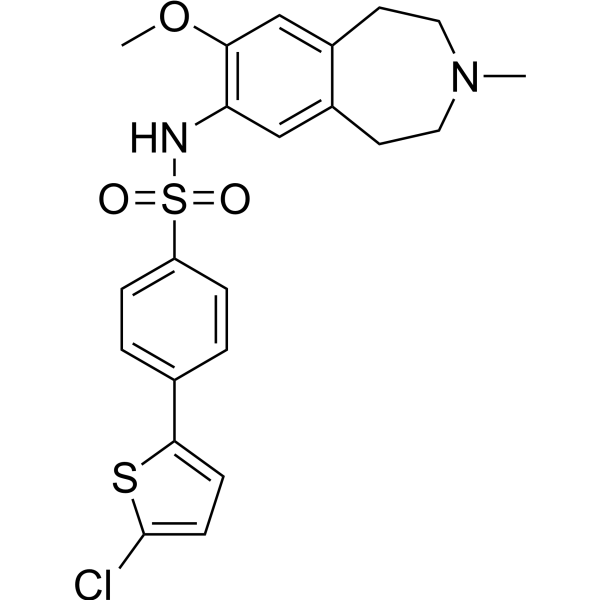
-
- HY-150403
-
-

-
- HY-12651
-
|
Primaquine phosphate; Primaquine bisphosphate
|
Parasite
|
Infection
Cancer
|
|
Primaquine diphosphate is a potent antimalaria agent and a potent gametocytocide in falciparum malaria. Primaquine diphosphate prevents relapse in vivax and ovale malaria .
|
-
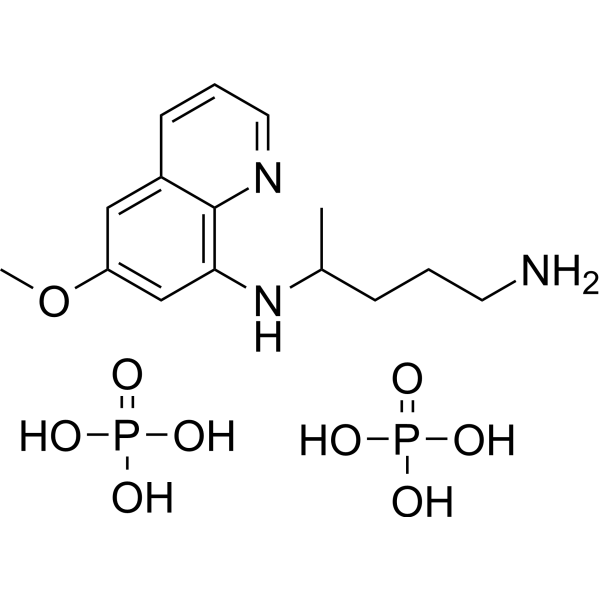
-
- HY-108831
-
|
|
Integrin
|
Inflammation/Immunology
|
|
Natalizumab is a recombinant, humanized IgG4 monoclonal antibody, binds to α4β1-integrin and blocks its interaction with vascular cell adhesion molecule-1 (VCAM-1). Natalizumab can be used for the treatment of relapsing remitting multiple sclerosis and Crohn's disease. Natalizumab is also the first targeted therapy which blocks an essential mechanism for lymphocyte entry to the CNS and thus prevents acute demyelinating relapses .
|
-

-
- HY-107094
-
|
W-212393 hydrochloride
|
Opioid Receptor
|
Neurological Disease
|
|
MT-7716 hydrochloride (W-212393 hydrochloride) is a selective non-peptide nociceptin receptor (NOP) agonist and promising potential treatment drug for alcohol abuse and relapse prevention .
|
-

-
- HY-107094A
-
|
W-212393
|
Opioid Receptor
|
Neurological Disease
|
|
MT-7716 free base (W-212393) is a selective non-peptide nociceptin receptor (NOP) agonist and promising potential treatment drug for alcohol abuse and relapse prevention .
|
-
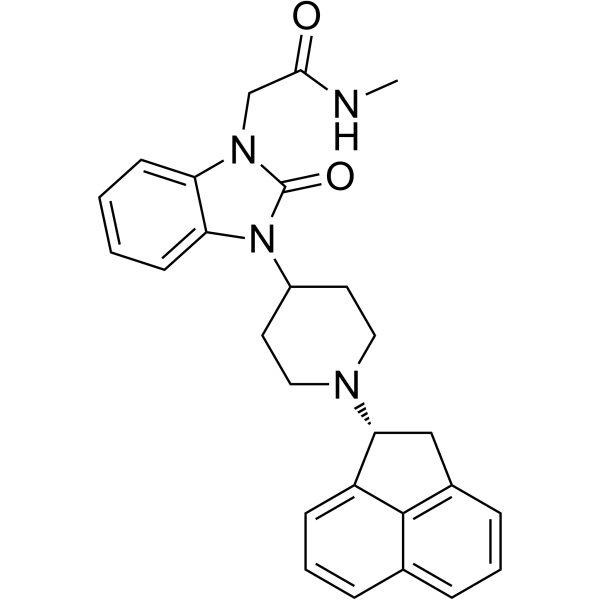
-
- HY-P9989
-
|
REGN5458
|
CD3
TNF Receptor
|
Cancer
|
|
Linvoseltamab is a bispecific antibody targeting to both BCMA (TNFRSF17) and CD3 epsilon. Linvoseltamab shows safety profile and encouraging efficacy in relapsed/refractory multiple myeloma (RRMM) models .
|
-

-
- HY-P99100
-
|
CTL-002
|
PD-1/PD-L1
|
Cancer
|
|
Visugromab is aGDF-15 neutralizing IgG4 mAb. Visugromab exhibits potent effecicacy in PD-1/PD-L1 relapsed/refractory metastatic solid tumors .
|
-

-
- HY-109117
-
|
ORY-1001
|
Histone Demethylase
|
Cancer
|
|
Iadademstat (ORY-1001) is a highly potent, orally active and selective LSD1 (KDM1A) inhibitor with antileukemic activity. Iadademstat can be used for relapsed or refractory acute myeloid leukemia research .
|
-
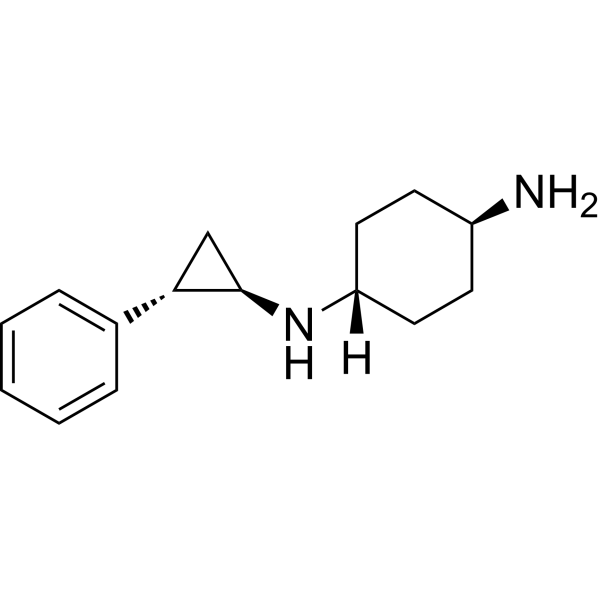
-
- HY-109108
-
|
DS-3201
|
Histone Methyltransferase
|
Cancer
|
|
Valemetostat (DS-3201), a first-in-class EZH1/2 dual inhibitor with IC50 values <10 nM. Valemetostat can be used for the research of relapsed/refractory peripheral T-cell lymphoma .
|
-

-
- HY-109108A
-
|
DS-3201 tosylate
|
Histone Methyltransferase
|
Cancer
|
|
Valemetostat (DS-3201) tosylate, a first-in-class EZH1/2 dual inhibitor with IC50 values <10 nM. Valemetostat tosylate can be used for the research of relapsed/refractory peripheral T-cell lymphoma .
|
-
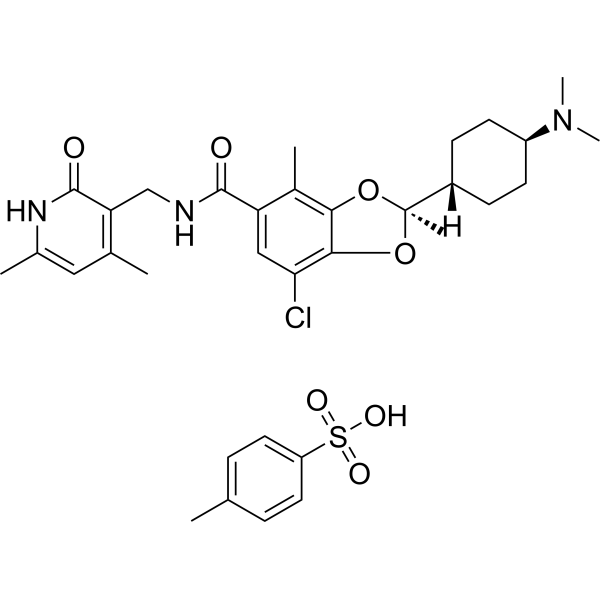
-
- HY-P99453
-
|
|
ADC Antibody
|
Cancer
|
|
Azintuxizumab is a monoclonal, targeting to B-cell maturation antigen (BCMA) and SLAMF7/CRACC/CD319, IgG1 bispecific antibody. Azintuxizumab has the potential for the research of relapsed/refractory multiple myeloma (RRMM) .
|
-

-
- HY-119264A
-
|
|
HIF/HIF Prolyl-Hydroxylase
Ras
|
Cancer
|
|
PRLX-93936 dihydrochloride (Compound 16) is a HIF-1α inhibitor with anticancer activity. PRLX-93936 can inhibit the activated Ras pathway and can be used in the study of relapsed or refractory multiple myeloma .
|
-
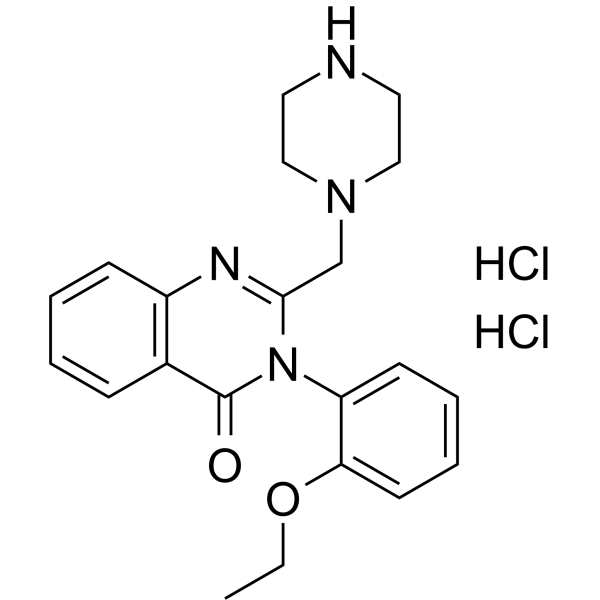
-
- HY-153773
-
|
|
IRE1
|
Cancer
|
|
Z4P is a BBB-permeable IRE1 inhibitor (IC50: 1.11 μM). Z4P inhibits Glioblastoma cell growth. Z4P prevents glioblastoma relapse when administered together with Temozolomide (HY-17364) .
|
-
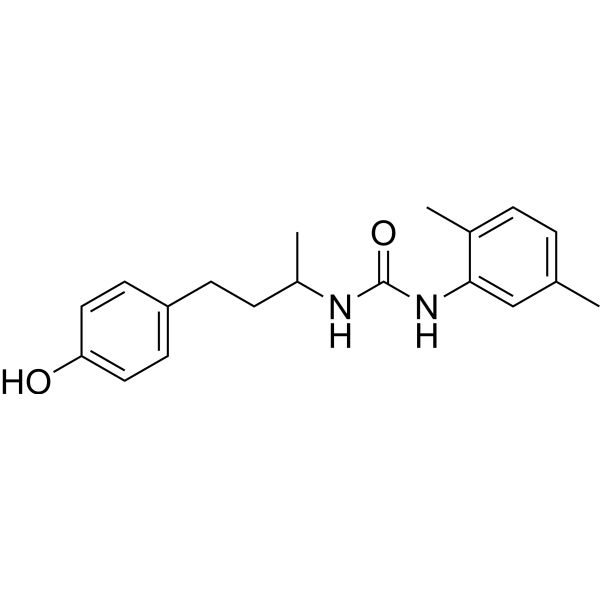
-
- HY-153939S
-
|
RG7388-d3-1
|
Isotope-Labeled Compounds
|
Cancer
|
|
Idasanutlin-d3-1 (RG7388-d3-1) is the deuterium labeled Idasanutlin. Idasanutlin is a potent antagonist of MDM2/p53. Idasanutlin inhibits relapsed or refractory acute myeloid leukemia .
|
-

-
- HY-155188
-
|
|
Bcl-2 Family
|
Neurological Disease
|
|
NWP-0476 is BCL-2/BCL-xL inhibitor. NWP-0476 has a modified structure with fine-tuned BCL-xL activity. NWP-0476 can be used for relapsed T-acute lymphoblastic leukemia (T-ALL) research .
|
-
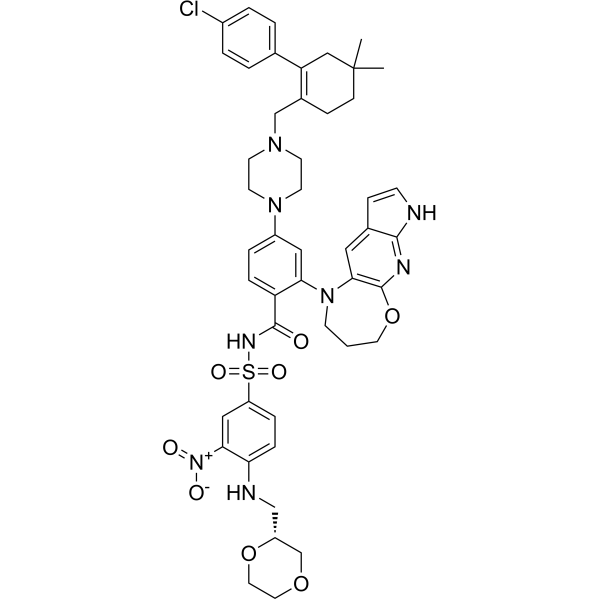
-
- HY-147413
-
|
TQ-B3101
|
EGFR
|
Cancer
|
|
Unecritinib (TQ-B3101) is a potent EGFR tyrosine kinase inhibitor. Unecritinib shows anticancer activity. Unecritinib inhibits ALK, ROS1, and MET. Unecritinib has the potential for the research of solid tumor and relapsed or refractory ALK-positive anaplastic large cell lymphoma .
|
-
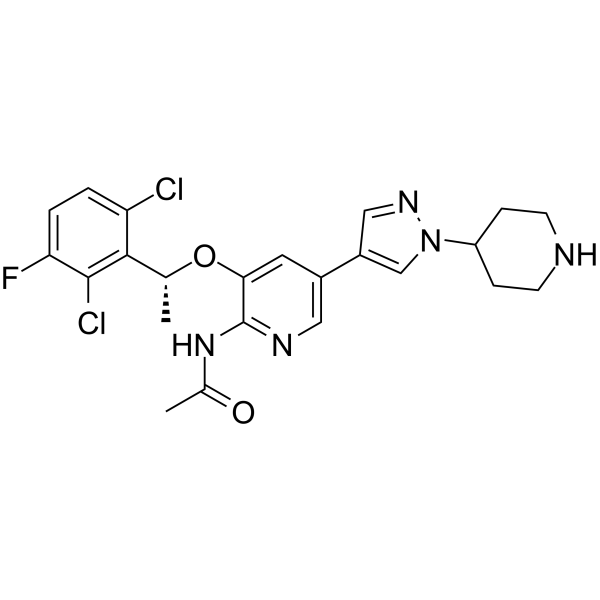
-
- HY-P99056
-
|
PF 05082566
|
TNF Receptor
|
Inflammation/Immunology
Cancer
|
|
Utomilumab (PF 05082566) is a fully human IgG2 mAb agonist of the T-cell costimulatory receptor 4-1BB/CD137. Utomilumab can be used for the research of relapsed/refractory follicular lymphoma (FL) and other CD20 + non-Hodgkin lymphomas (NHL) .
|
-

-
- HY-139481
-
|
|
Btk
|
Infection
Cancer
|
|
TL-895 is a potent, orally active, ATP-competitive, and highly selective irreversible BTK inhibitor with an IC50 and a Ki of 1.5 nM and 11.9 nM, respectively . TL-895 is used be for JAKi-relapsed/refractory myelofibrosis, acute myeloid leukemia, COVID-19 and cancer research .
|
-
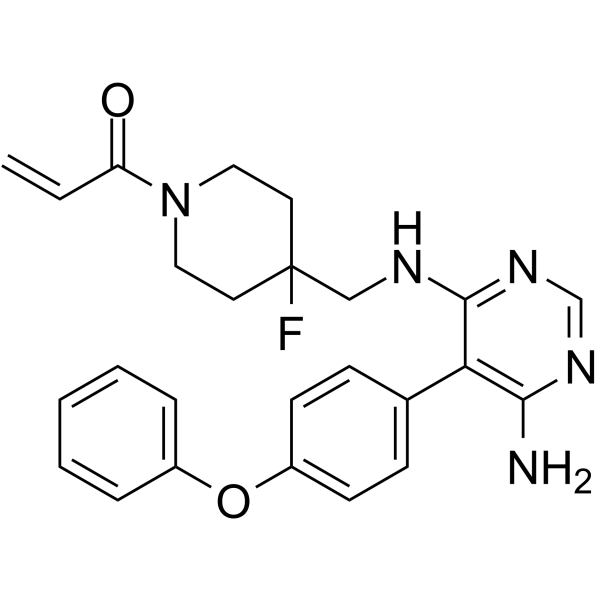
-
- HY-10224A
-
|
LBH589 lactate; NVP-LBH589 lactate
|
HDAC
HIV
Autophagy
Apoptosis
|
Infection
Cancer
|
|
Panobinostat lactate is a potent and orally active non-selective HDAC inhibitor. Panobinostat lactate has antineoplastic activities. Panobinostat lactate effectively disrupts HIV latency. Panobinostat lactate induces cell apoptosis and autophagy. Panobinostat lactate can be used for the study of refractory or relapsed multiple myeloma .
|
-
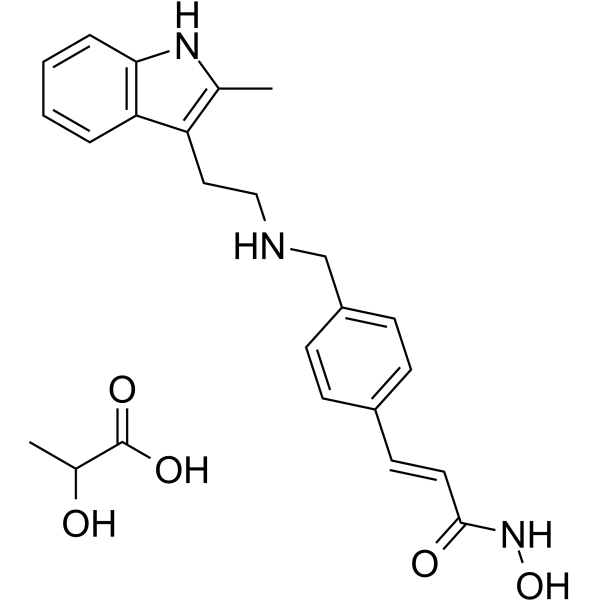
-
- HY-P99730
-
|
TAK-079
|
CD38
|
Cancer
|
|
Mezagitamab (TAK-079) is a IgG1λ anti-CD38 monoclonal antibody. Mezagitamab depletes tumor cells expressing CD38 through antibody and complement dependent cytotoxicity. Mezagitamab has potential application in relapsed/refractory multiple myeloma (RRMM) and idiopathic thrombocytopenic purpura (ITP) .
|
-

-
- HY-112037
-
|
IACS-10759
|
Oxidative Phosphorylation
Mitochondrial Metabolism
Apoptosis
|
Cancer
|
|
IACS-010759 is an orally active, potent mitochondrial complex I of oxidative phosphorylation (OXPHOS) inhibitor. IACS-010759 inhibits proliferation and induces apoptosis in models of brain cancer and acute myeloid leukemia (AML) reliant on OXPHOS. IACS-010759 has the potential for relapsed/refractory AML and solid tumors research .
|
-

-
- HY-112037A
-
|
IACS-10759 hydrochloride
|
Oxidative Phosphorylation
Mitochondrial Metabolism
Apoptosis
|
Cancer
|
|
IACS-010759 hydrochlorideis an orally active, potent mitochondrial complex I of oxidative phosphorylation (OXPHOS) inhibitor. IACS-010759 hydrochlorideinhibits proliferation and induces apoptosis in models of brain cancer and acute myeloid leukemia (AML) reliant on OXPHOS. IACS-010759 hydrochloride has the potential for relapsed/refractory AML and solid tumors research .
|
-
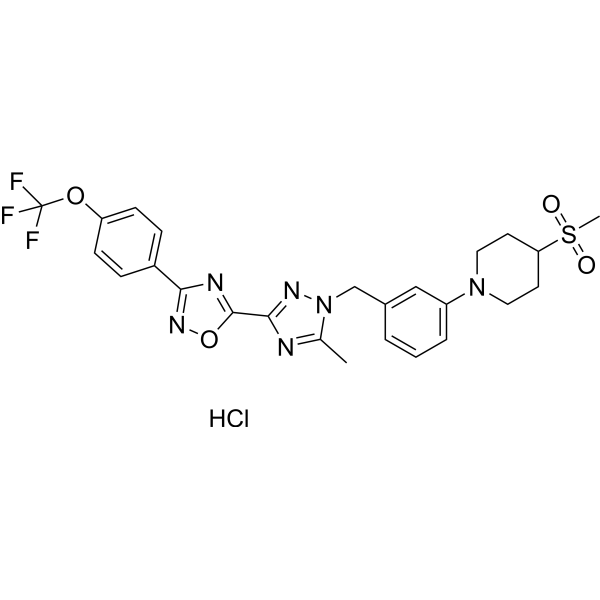
-
- HY-P99107
-
|
|
Antibody-Drug Conjugates (ADCs)
Apoptosis
TNF Receptor
|
Cancer
|
|
Brentuximab vedotin (cAC10-vcMMAE) is an antibody-drug conjugate (ADC) comprising an anti-CD30 antibody and the cytotoxic agent Monomethyl auristatin E (MMAE). Brentuximab vedotin inhibits CD30-positive cells with an IC50 of 2.5 ng/mL. Brentuximab vedotin can be used for the research of relapsed and refractory Hodgkin lymphoma .
|
-

-
- HY-101563
-
|
EPZ015938
|
Histone Methyltransferase
SARS-CoV
MDM-2/p53
CDK
Apoptosis
|
Infection
Cancer
|
|
GSK3326595 is a protein arginine methyltransferase 5 (PRMT5) inhibitor. GSK3326595 decreases SARS-CoV-2 infection, inhibits cancer cell proliferation and induces pro-inflammatory macrophage polarization and increases hepatic triglyceride levels without affecting atherosclerosis. GSK3326595 can be used for research of relapsed/refractory mantle cell lymphoma .
|
-
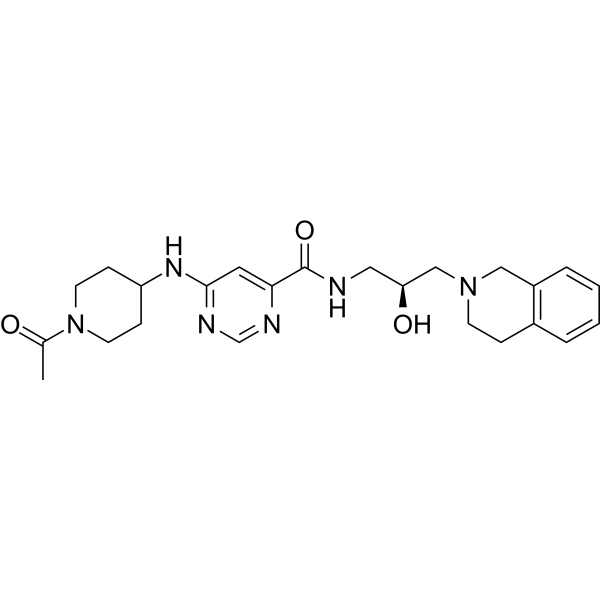
-
- HY-P99024
-
|
RO7082859
|
CD20
|
Cancer
|
|
Glofitamab (RO7082859) is a T-cell-engaging bispecific antibody possessing a novel 2:1 structure with bivalency for CD20 on B cells and monovalency for CD3 on T cells. Glofitamab leads to T-cell activation, proliferation, and tumor cell killing upon binding to CD20 on malignant cells. Glofitamab induces durable complete remissions in relapsed or refractory B-Cell lymphoma .
|
-

-
- HY-10446
-
|
|
Antifolate
Apoptosis
|
Cancer
|
|
Pralatrexate is an antifolate and is a potent dihydrofolate reductasean (DHFR) inhibitor with a Ki of 13.4 pM. Pralatrexate is a substrate for folylpolyglutamate synthetase with improved cellular uptake and retention. Pralatrexate has antitumor activities and has the potential for relapsed/refractory T-cell lymphoma treatment . Pralatrexate is a click chemistry reagent, it contains an Alkyne group and can undergo copper-catalyzed azide-alkyne cycloaddition (CuAAc) with molecules containing Azide groups.
|
-
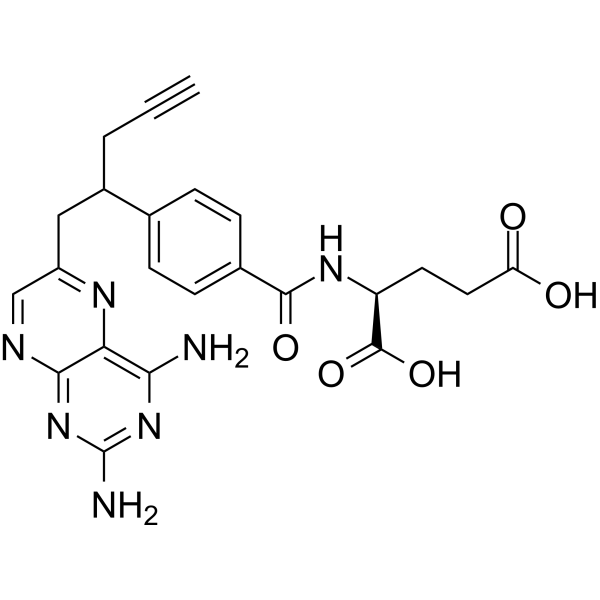
-
- HY-P99740
-
|
|
CD276/B7-H3
|
Cancer
|
|
Mirzotamab is an IgG1κ antibody targeting to CD276/B7-H3. Mirzotamab can conjugates with Clezutoclax (HY-137774), an BCL inhibitor to form Mirzotamab clezutoclax (HY-P99741), involving in research with taxane research in relapsed/refractory solid tumors. Mirzotamab clezutoclax (ABBV-155) is a targeted antibody drug conjugate (ADC) .
|
-

-
- HY-10224
-
Panobinostat
Maximum Cited Publications
54 Publications Verification
LBH589; NVP-LBH589
|
HDAC
Autophagy
HIV
Apoptosis
|
Cancer
|
|
Panobinostat (LBH589; NVP-LBH589) is a potent and orally active non-selective HDAC inhibitor, and has antineoplastic activities . Panobinostat induces HIV-1 virus production even at low concentration range 8-31 nM, stimulates HIV-1 expression in latently infected cells . Panobinostat induces cell apoptosis and autophagy. Panobinostat can be used for the study of refractory or relapsed multiple myeloma .
|
-
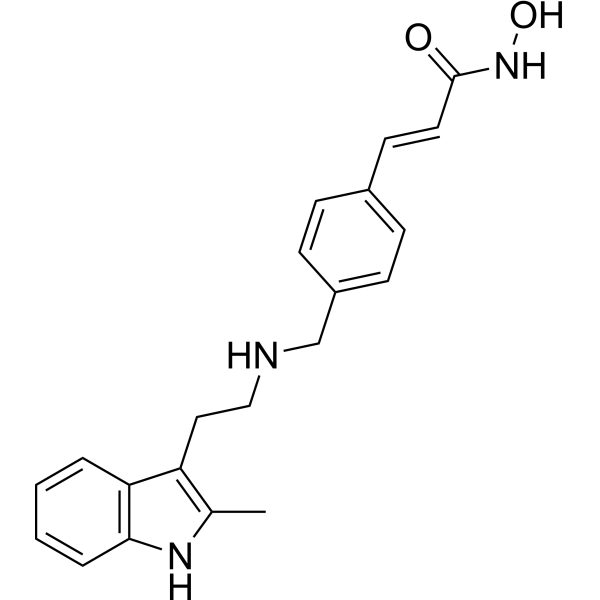
-
- HY-12288
-
|
RPC-1063
|
LPL Receptor
|
Neurological Disease
Inflammation/Immunology
|
|
Ozanimod (RPC-1063), a sphingosine 1-phosphate (S1P) receptor modulator that binds with high affinity selectively to S1P receptor subtypes 1 (S1P1) and 5 (S1P5). Ozanimod has modulate effect for hS1P1 and hS1P5 receptor with EC50s of 1.03 nM and 8.6 nM, respectively. Ozanimod can be used for the research of relapsing multiple sclerosis (MS) .
|
-

-
- HY-114778
-
|
SHR3162; Fuzuloparib
|
PARP
|
Cancer
|
|
Fluzoparib (SHR3162) is a potent and orally active PARP1 inhibitor (IC50=1.46±0.72 nM, a cell‐free enzymatic assay) with superior antitumor activity. Fluzoparib selectively inhibits the proliferation of homologous recombination repair (HR)‐deficient cells, and sensitizes both HR‐deficient and HR‐proficient cells to cytotoxic agents. Fluzoparib exhibits good pharmacokinetic properties in vivo and can be used for BRCA1/2-mutant relapsed ovarian cancer research .
|
-
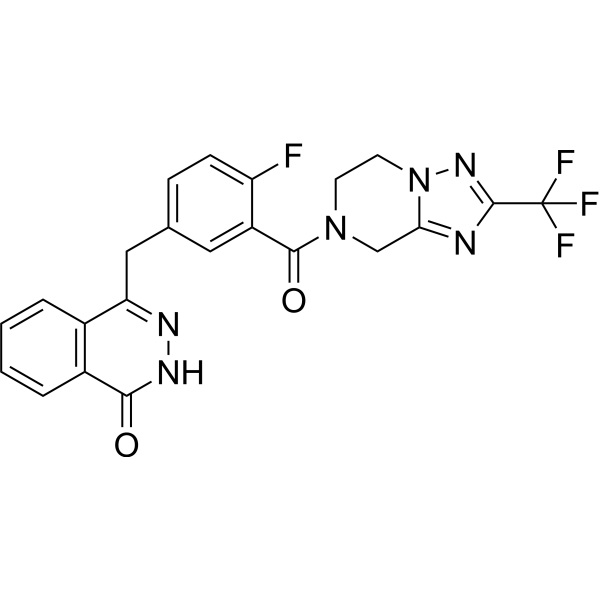
-
- HY-12288A
-
|
RPC-1063 hydrochloride
|
LPL Receptor
|
Neurological Disease
Inflammation/Immunology
|
|
Ozanimod (RPC-1063) hydrochloride, a sphingosine 1-phosphate (S1P) receptor modulator that binds with high affinity selectively to S1P receptor subtypes 1 (S1P1) and 5 (S1P5). Ozanimod hydrochloride has modulate effect for hS1P1 and hS1P5 receptor with EC50s of 1.03 nM and 8.6 nM, respectively. Ozanimod hydrochloride can be used for the research of relapsing multiple sclerosis (MS) .
|
-

-
- HY-13010S
-
|
ABR-215062-d5
|
Isotope-Labeled Compounds
Apoptosis
NF-κB
|
Inflammation/Immunology
|
|
Laquinimod-d5 (ABR-215062-d5) is deuterium labeled Laquinimod. Laquinimod (ABR-215062), an orally available carboxamide derivative, is a potent immunomodulator that prevents neurodegeneration and inflammation in the central nervous system. Laquinimod reduces astrocytic NF-κB activation to protect from Cuprizone-induced demyelination. Laquinimod has the potential for relapsing-remitting (RR) and chronic progressive (CP) forms of multiple sclerosis (MS; RRMS or CPMS) as well as neurodegenerative diseases research .
|
-

-
- HY-10224S
-
|
LBH589-d4; NVP-LBH589-d4
|
HDAC
Autophagy
HIV
Apoptosis
|
Cancer
|
|
Panobinostat-d4 is the deuterium labeled Panobinostat. Panobinostat (LBH589; NVP-LBH589) is a potent and orally active non-selective HDAC inhibitor, and has antineoplastic activities[1][2]. Panobinostat induces HIV-1 virus production even at low concentration range 8-31 nM, stimulates HIV-1 expression in latently infected cells[4]. Panobinostat induces cell apoptosis and autophagy. Panobinostat can be used for the study of refractory or relapsed multiple myeloma[3].
|
-

-
- HY-10224S1
-
|
LBH589-d4 hydrochloride; NVP-LBH589-d4 hydrochloride
|
Isotope-Labeled Compounds
HDAC
Autophagy
HIV
Apoptosis
|
Cancer
|
|
Panobinostat-d4 (hydrochloride) is deuterium labeled Panobinostat. Panobinostat (LBH589; NVP-LBH589) is a potent and orally active non-selective HDAC inhibitor, and has antineoplastic activities[1][2]. Panobinostat induces HIV-1 virus production even at low concentration range 8-31 nM, stimulates HIV-1 expression in latently infected cells[4]. Panobinostat induces cell apoptosis and autophagy. Panobinostat can be used for the study of refractory or relapsed multiple myeloma[3].
|
-

-
- HY-12288R
-
|
|
LPL Receptor
|
Neurological Disease
Inflammation/Immunology
|
|
Ozanimod (Standard) is the analytical standard of Ozanimod. This product is intended for research and analytical applications. Ozanimod (RPC-1063), a sphingosine 1-phosphate (S1P) receptor modulator that binds with high affinity selectively to S1P receptor subtypes 1 (S1P1) and 5 (S1P5). Ozanimod has modulate effect for hS1P1 and hS1P5 receptor with EC50s of 1.03 nM and 8.6 nM, respectively. Ozanimod can be used for the research of relapsing multiple sclerosis (MS) .
|
-

-
- HY-153857
-
|
|
FLT3
|
Cancer
|
|
PHI-101 is an orally active FLT3 inhibitor that overcomes resistance to multiple drug-resistant mutations. PHI-101 potently inhibits FLT3 single activating mutations (ITD or TKD mutants) and has inhibitory activity against FLT3 double (ITD/D835Y or ITD/F691L) and triple (ITD/D835Y/F691L) resistance mutations. PHI-101 has potential for research in relapsed or refractory acute myeloid leukemia (AML) .
|
-
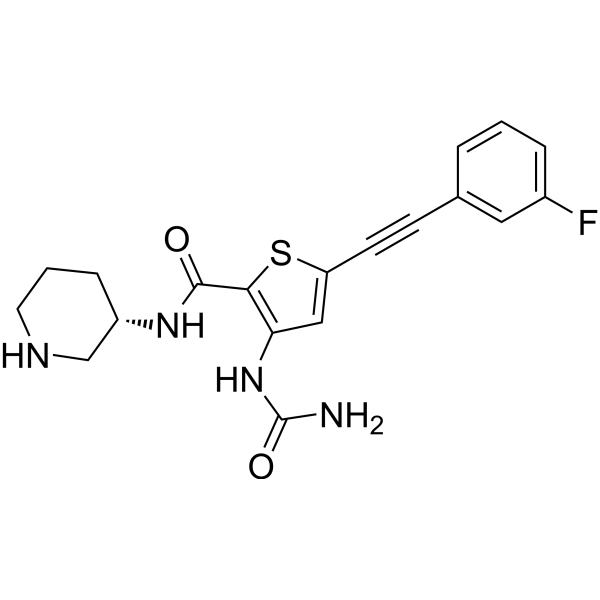
-
- HY-125726
-
|
(3'-sulfo)Galβ-Cer(d18:1/24:1); N-Nervonoyl Sulfatide; C24:1 Sulfatide
|
Others
|
Inflammation/Immunology
|
|
Sulfo galactosylceramide (N-Nervonoyl Sulfatide; C24:1 Sulfatide) is a member of the sulfatide class of glycolipids. It is the predominate sulfatide species in mature myelin, and it accumulates at a higher rate than C24 3’-sulfo galactosylceramide in rat cerebellum from seven to 32 days of age when active myelination occurs. It interacts with C-type lectins and immunoglobulin-like receptors with the highest affinity for LMIR5. It induces production of MCP-1 in basophils but not mast cells and increases the activation of NFAT in a reporter assay via LMIR5. Sulfo galactosylceramide is an immunodominant species in myelin, is bound by CD1d in vitro, and increases proliferation in isolated mouse splenocytes. It reduces symptoms and increases survival in a mouse model of chronic relapsing-remitting experimental autoimmune encephalomyelitis (EAE) when used at a dose of 20 μg. It also decreases the number of inflammatory lesions and infiltrating mononuclear cells in the lumbar spinal cord of EAE mice. As this product is derived from a natural source, there may be variations in the sphingoid backbone.
|
-

| Cat. No. |
Product Name |
Target |
Research Area |
-
- HY-P1240
-
|
MOG (35-55)
|
Peptides
|
Neurological Disease
Inflammation/Immunology
|
|
Myelin Oligodendrocyte Glycoprotein Peptide (35-55), mouse, rat (MOG (35-55)) is a minor component of CNS myelin. Myelin Oligodendrocyte Glycoprotein Peptide (35-55), mouse, rat has encephalitogenic activity and induces T cell proliferative. Myelin Oligodendrocyte Glycoprotein Peptide (35-55), mouse, rat induces Th1 cytokine response as well as relatively high levels of IgG antibodies. Myelin Oligodendrocyte Glycoprotein Peptide (35-55), mouse, rat produces a relapsing-remitting neurological disease with extensive plaque-like demyelination .
|
-
- HY-P1240B
-
|
MOG (35-55) (acetate)
|
Peptides
|
Neurological Disease
Inflammation/Immunology
|
|
Myelin Oligodendrocyte Glycoprotein Peptide (35-55), mouse, rat (MOG (35-55)) acetate is a minor component of CNS myelin. Myelin Oligodendrocyte Glycoprotein Peptide (35-55), mouse, rat acetate has encephalitogenic activity and induces T cell proliferative. Myelin Oligodendrocyte Glycoprotein Peptide (35-55), mouse, rat acetate induces Th1 cytokine response as well as relatively high levels of IgG antibodies. Myelin Oligodendrocyte Glycoprotein Peptide (35-55), mouse, rat acetate produces a relapsing-remitting neurological disease with extensive plaque-like demyelination .
|
-
- HY-P1240A
-
|
MOG (35-55) (TFA)
|
Peptides
|
Neurological Disease
Inflammation/Immunology
|
|
Myelin Oligodendrocyte Glycoprotein Peptide (35-55), mouse, rat (MOG (35-55)) TFA is a minor component of CNS myelin. Myelin Oligodendrocyte Glycoprotein Peptide (35-55), mouse, rat TFA has encephalitogenic activity and induces T cell proliferative. Myelin Oligodendrocyte Glycoprotein Peptide (35-55), mouse, rat TFA induces Th1 cytokine response as well as relatively high levels of IgG antibodies. Myelin Oligodendrocyte Glycoprotein Peptide (35-55), mouse, rat TFA produces a relapsing-remitting neurological disease with extensive plaque-like demyelination .
|
| Cat. No. |
Product Name |
Target |
Research Area |
-
- HY-P99780
-
-
- HY-108831A
-
|
|
Integrin
|
Inflammation/Immunology
|
|
Natalizumab (Solution) is a recombinant, humanized IgG4 monoclonal antibody, binds to α4β1-integrin and blocks its interaction with vascular cell adhesion molecule-1 (VCAM-1). Natalizumab can be used for the treatment of relapsing remitting multiple sclerosis and Crohn's disease. Natalizumab is also the first targeted therapy which blocks an essential mechanism for lymphocyte entry to the CNS and thus prevents acute demyelinating relapses .
|
-
- HY-P99033
-
|
BTCT-4465A
|
CD20
CD3
|
Inflammation/Immunology
Cancer
|
|
Mosunetuzumab (BTCT-4465A) is a full-length, fully humanized immunoglobulin G1 (IgG1) T-cell-dependent bispecific (TDB) antibody targeting CD20 (B cells) and CD3 (T cells). Mosunetuzumab redirects T cells to engage and eliminate malignant B cells and can be used for the research of relapsed or refractory (R/R) B-cell non-Hodgkin lymphomas (B-NHLs) .
|
-
- HY-108831
-
|
|
Integrin
|
Inflammation/Immunology
|
|
Natalizumab is a recombinant, humanized IgG4 monoclonal antibody, binds to α4β1-integrin and blocks its interaction with vascular cell adhesion molecule-1 (VCAM-1). Natalizumab can be used for the treatment of relapsing remitting multiple sclerosis and Crohn's disease. Natalizumab is also the first targeted therapy which blocks an essential mechanism for lymphocyte entry to the CNS and thus prevents acute demyelinating relapses .
|
-
- HY-P9989
-
|
REGN5458
|
CD3
TNF Receptor
|
Cancer
|
|
Linvoseltamab is a bispecific antibody targeting to both BCMA (TNFRSF17) and CD3 epsilon. Linvoseltamab shows safety profile and encouraging efficacy in relapsed/refractory multiple myeloma (RRMM) models .
|
-
- HY-P99100
-
|
CTL-002
|
PD-1/PD-L1
|
Cancer
|
|
Visugromab is aGDF-15 neutralizing IgG4 mAb. Visugromab exhibits potent effecicacy in PD-1/PD-L1 relapsed/refractory metastatic solid tumors .
|
-
- HY-P99453
-
|
|
ADC Antibody
|
Cancer
|
|
Azintuxizumab is a monoclonal, targeting to B-cell maturation antigen (BCMA) and SLAMF7/CRACC/CD319, IgG1 bispecific antibody. Azintuxizumab has the potential for the research of relapsed/refractory multiple myeloma (RRMM) .
|
-
- HY-P9965
-
|
HuLuc 63; PDL 063; BMS 901608
|
Inhibitory Antibodies
|
Cancer
|
|
Elotuzumab is a monoclonal antibody directed against the SLAMF7 receptor. Elotuzumab has no significant antimyeloma activity when given as a single agent with relapsed or refractory multiple myeloma (RRMM). Elotuzumab results in improved response and outcome when combined with other antimyeloma agents .
|
-
- HY-P99056
-
|
PF 05082566
|
TNF Receptor
|
Inflammation/Immunology
Cancer
|
|
Utomilumab (PF 05082566) is a fully human IgG2 mAb agonist of the T-cell costimulatory receptor 4-1BB/CD137. Utomilumab can be used for the research of relapsed/refractory follicular lymphoma (FL) and other CD20 + non-Hodgkin lymphomas (NHL) .
|
-
- HY-P99730
-
|
TAK-079
|
CD38
|
Cancer
|
|
Mezagitamab (TAK-079) is a IgG1λ anti-CD38 monoclonal antibody. Mezagitamab depletes tumor cells expressing CD38 through antibody and complement dependent cytotoxicity. Mezagitamab has potential application in relapsed/refractory multiple myeloma (RRMM) and idiopathic thrombocytopenic purpura (ITP) .
|
-
- HY-P99024
-
|
RO7082859
|
CD20
|
Cancer
|
|
Glofitamab (RO7082859) is a T-cell-engaging bispecific antibody possessing a novel 2:1 structure with bivalency for CD20 on B cells and monovalency for CD3 on T cells. Glofitamab leads to T-cell activation, proliferation, and tumor cell killing upon binding to CD20 on malignant cells. Glofitamab induces durable complete remissions in relapsed or refractory B-Cell lymphoma .
|
-
- HY-P99740
-
|
|
CD276/B7-H3
|
Cancer
|
|
Mirzotamab is an IgG1κ antibody targeting to CD276/B7-H3. Mirzotamab can conjugates with Clezutoclax (HY-137774), an BCL inhibitor to form Mirzotamab clezutoclax (HY-P99741), involving in research with taxane research in relapsed/refractory solid tumors. Mirzotamab clezutoclax (ABBV-155) is a targeted antibody drug conjugate (ADC) .
|
| Cat. No. |
Product Name |
Chemical Structure |
-
- HY-153939S
-
|
|
|
Idasanutlin-d3-1 (RG7388-d3-1) is the deuterium labeled Idasanutlin. Idasanutlin is a potent antagonist of MDM2/p53. Idasanutlin inhibits relapsed or refractory acute myeloid leukemia .
|
-

-
- HY-13010S
-
|
|
|
Laquinimod-d5 (ABR-215062-d5) is deuterium labeled Laquinimod. Laquinimod (ABR-215062), an orally available carboxamide derivative, is a potent immunomodulator that prevents neurodegeneration and inflammation in the central nervous system. Laquinimod reduces astrocytic NF-κB activation to protect from Cuprizone-induced demyelination. Laquinimod has the potential for relapsing-remitting (RR) and chronic progressive (CP) forms of multiple sclerosis (MS; RRMS or CPMS) as well as neurodegenerative diseases research .
|
-

-
- HY-10224S
-
|
|
|
Panobinostat-d4 is the deuterium labeled Panobinostat. Panobinostat (LBH589; NVP-LBH589) is a potent and orally active non-selective HDAC inhibitor, and has antineoplastic activities[1][2]. Panobinostat induces HIV-1 virus production even at low concentration range 8-31 nM, stimulates HIV-1 expression in latently infected cells[4]. Panobinostat induces cell apoptosis and autophagy. Panobinostat can be used for the study of refractory or relapsed multiple myeloma[3].
|
-

-
- HY-10224S1
-
|
|
|
Panobinostat-d4 (hydrochloride) is deuterium labeled Panobinostat. Panobinostat (LBH589; NVP-LBH589) is a potent and orally active non-selective HDAC inhibitor, and has antineoplastic activities[1][2]. Panobinostat induces HIV-1 virus production even at low concentration range 8-31 nM, stimulates HIV-1 expression in latently infected cells[4]. Panobinostat induces cell apoptosis and autophagy. Panobinostat can be used for the study of refractory or relapsed multiple myeloma[3].
|
-

| Cat. No. |
Product Name |
|
Classification |
-
- HY-10446
-
|
|
|
Alkynes
|
|
Pralatrexate is an antifolate and is a potent dihydrofolate reductasean (DHFR) inhibitor with a Ki of 13.4 pM. Pralatrexate is a substrate for folylpolyglutamate synthetase with improved cellular uptake and retention. Pralatrexate has antitumor activities and has the potential for relapsed/refractory T-cell lymphoma treatment . Pralatrexate is a click chemistry reagent, it contains an Alkyne group and can undergo copper-catalyzed azide-alkyne cycloaddition (CuAAc) with molecules containing Azide groups.
|
Your information is safe with us. * Required Fields.
Inquiry Information
- Product Name:
- Cat. No.:
- Quantity:
- MCE Japan Authorized Agent:


























































